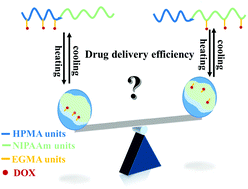A comparison study to investigate the effect of the drug-loading site on its delivery efficacy using double hydrophilic block copolymer-based prodrugs†
Abstract
Polymeric delivery vehicles can improve the safety and efficacy of chemotherapy drugs by facilitating preferential tumor delivery. Double hydrophilic block copolymer (DHBC)-based prodrugs are considered as ideal candidates for drug delivery due to the elegant integration of benefits from both structures including polymeric prodrugs’ superior protection and minimal premature drug release using covalent links and a DHBC-based “green” self-assembly strategy by a simple stimulus in a pure aqueous phase without the use of any organic solvent. Clearly, the location of drug molecules in the polymeric prodrugs has exerted a significant effect on their therapeutic efficiency. However, there has been no published data so far, to our knowledge, reporting the effect of drug-conjugated sites on its therapeutic efficacy, as well as some basic guidelines that can be followed to direct the future design of polymeric prodrugs. To this end, herein a thermo-sensitive DHBC, poly(N-(2-hydroxypropyl) methacrylamide)-b-poly(N-isopropyl acrylamide) (P(HPMA)-b-P(NIPAAm)), was designed and synthesized by successive reversible addition and fragmentation chain transfer (RAFT) polymerizations, and was chosen as a platform to clarify this issue. An anti-cancer drug, doxorubicin (DOX) was conjugated to the hydrophilic PHPMA block and the temperature-responsive P(NIPAAm) block, respectively, through a pH-liable hydrazone bond to fabricate two different types of polymeric prodrugs with the drug tethered to the micellar hydrophilic PHPMA shell or encapsulated within the hydrophobic P(NIPAAm) core upon temperature elevation above its lower critical solution temperature (LCST). A detailed comparison study was carried out to investigate which structure exhibits better properties and higher therapeutic efficacy in terms of micellar size, stability, cellular uptake, drug loading capacity, drug release behaviors and cell viability. The results showed the self-assembly of both DHBC-based prodrugs into well-dispersed spherical micelles with similar average hydrodynamic diameters (Dh) around 150 nm in phosphate buffer (PBS, pH 7.4) at 37 °C, but a higher drug loading content (DLC), and enhanced pH-mediated drug release, i.e., much accelerated drug release at pH 5.0, while slower at pH 7.4, as well as enhanced cytotoxicity when the drug was conjugated to the hydrophilic shell of the micelles. The guidelines obtained in this study are thus believed to direct the future design and development of polymeric prodrugs for efficient cancer therapy.

- This article is part of the themed collection: Journal of Materials Chemistry B Emerging Investigators


 Please wait while we load your content...
Please wait while we load your content...